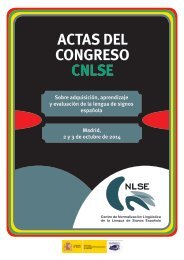ACTAS DEL CONGRESO CNLSE
1NMV0EE
1NMV0EE
Create successful ePaper yourself
Turn your PDF publications into a flip-book with our unique Google optimized e-Paper software.
PONENCIAS Y COMUNICACIONES <strong>DEL</strong> <strong>CONGRESO</strong> <strong>CNLSE</strong> SOBRE ADQUISICIÓN,<br />
76 APRENDIZAJE Y EVALUACIÓN DE LA LENGUA DE SIGNOS ESPAÑOLA 2014<br />
castellano. Por otro, también pretendemos comprobar si el coste asimétrico también ocurre cuando<br />
bilingües bimodales oyentes cambian entre castellano y LSE.<br />
3. Referencias bibliográficas<br />
BIALYSTOK, E. et al. (2009): «Bilingual minds», Psychological Science in the Public Interest, 10(3): 89-129.<br />
COLOMÉ, À. (2001): «Lexical activation in bilinguals’ speech production: Language-specific or languageindependent?«<br />
Journal of memory and language, 45(4): 721-736.<br />
COSTA, A.; SANTESTEBAN, M. e IVANOVA, I. (2006): «How do highly proficient bilinguals control their lexicalization<br />
process? Inhibitory and language-specific selection mechanisms are both functional», Journal<br />
of Experimental Psychology: Learning, Memory, and Cognition, 32(5): 1057.<br />
EMMOREY, K. et al. (2008a): «Bimodal bilingualism», Bilingualism: Language and Cognition, 11: 43-61.<br />
EMMOREY, K. et al. (2008b): «The Source of Enhanced Cognitive Control in Bilinguals Evidence From Bimodal<br />
Bilinguals», Psychological Science, 19(12): 1201-1206.<br />
FINKBEINER, M. et al. (2006): «Lexical selection in bilingual speech production does not involve language<br />
suppression», Journal of Experimental Psychology: Learning, Memory, and Cognition, 32(5): 1075.<br />
GREEN, D. W. (1998): «Mental control of the bilingual lexico-semantic system», Bilingualism: Language and<br />
cognition, 1(2): 67-81.<br />
GROTE, K. y LINZ, E. (2003): «The influence of sign language iconicity on semantic conceptualization». En:<br />
Muller, W.G. y Fisher, O. (eds.): From sign to signing: Iconicity in language and literature 3, Amsterdam:<br />
John Benjamins: 23–40.<br />
JACKSON, G. M. et al. (2001): «ERP correlates of executive control during repeated language switching», Bilingualism:<br />
Language and Cognition, 4(02): 169-178.<br />
KROLL, J. F.; BOBB, S. C. y WODNIECKA, Z. (2006): «Language selectivity is the exception, not the rule: Arguments<br />
against a fixed locus of language selection in bilingual speech», Bilingualism: Language and<br />
Cognition, 9(2): 119-135.<br />
KUBUS, O. et al. (2014): «Word recognition in deaf readers: Cross-language activation of German Sign Language<br />
and German», Applied Psycholinguistics: 1-24.<br />
MEUTER, R. F. y ALLPORT, A. (1999): «Bilingual language switching in naming: Asymmetrical costs of language<br />
selection», Journal of memory and language, 40(1): 25-40.<br />
MEUTER, R. F. (2005): «Language Selection in Bilinguals: mechanisms and processes». En: Kroll, J. y De<br />
Groot, A. (eds.): Handbook of Bilingualism: Psycholinguistic Approaches, Oxford: Oxford University<br />
Press: 349-370.<br />
MONSELL, S. (2003): «Task switching», Trends in cognitive sciences, 7(3): 134-140.<br />
MORFORD, J. P. et al. (2011): «When deaf signers read English: Do written words activate their sign translations?»<br />
Cognition, 118(2): 286-292.




